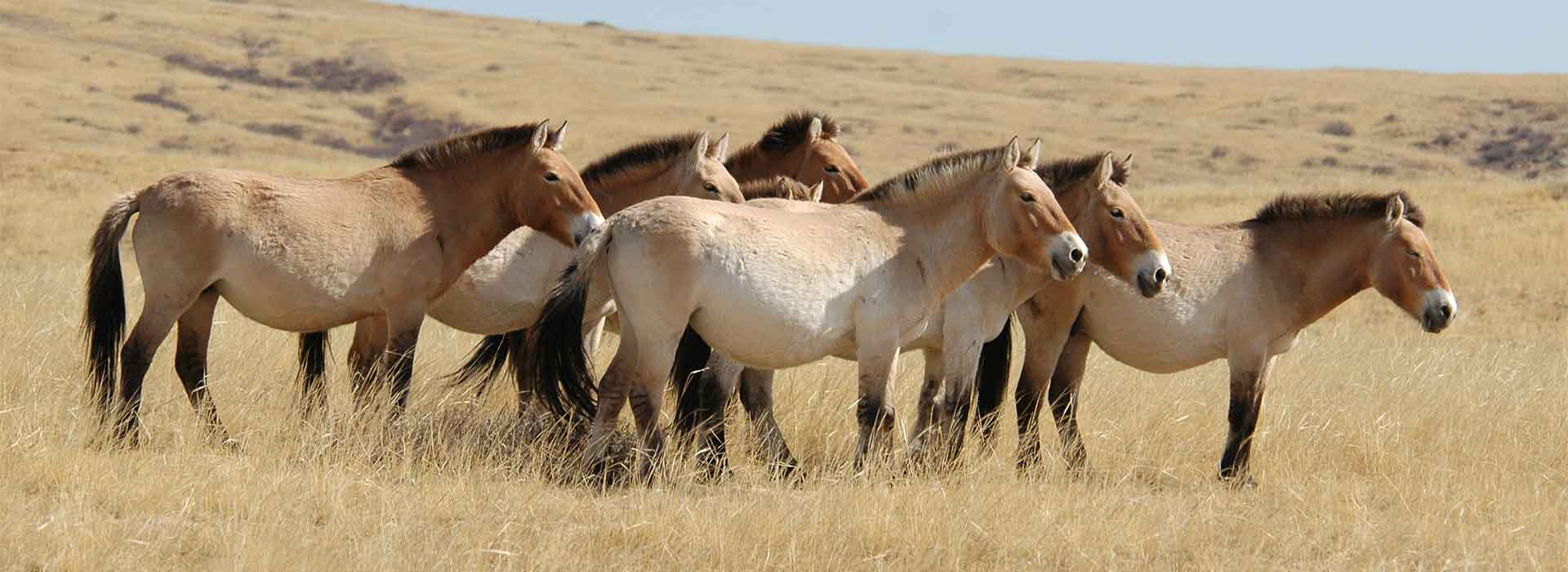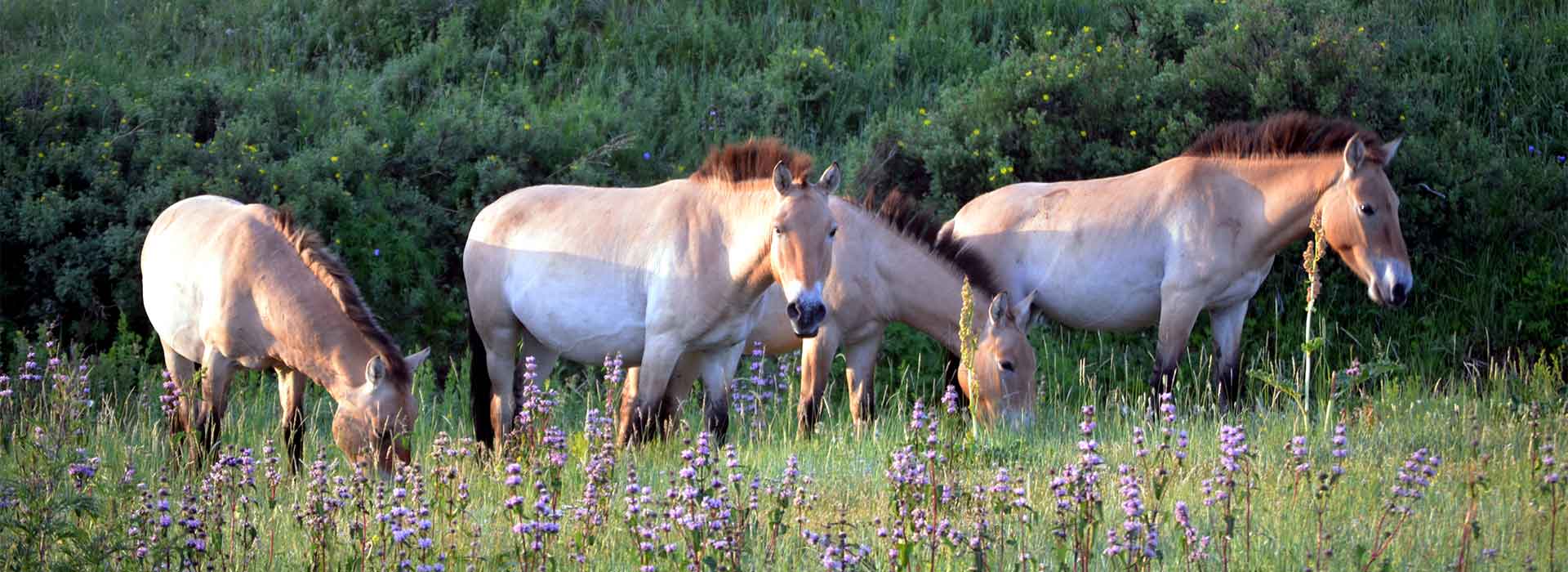Takhi re-introduction
Takhi Re-Introduction
Takhi – The last known species of wild horses
The takhi’s (Equus Przewalskii) colour ranges from yellowish to reddish-brown. Around the nostrils and the mouth there is a white coloration – the so called flour nose. Its body seems plump with a strong neck and heavy limbs.
The takhi’s mane stands upright. From the mane to the tail blends a dark dorsal stripe. Unlike the domestic horse, the takhi’s onset of the tail is prolonged downwards. The takhi sheds its fur – the short hair in summer is replaced by a longer one with very thick sub-wool in winter.
The shoulder height of the wild horse ranges from 125 to 147 cm and it weighs between 240 and 300 kg. On the contrary to the domestic horse the Przewalskii’s Horse number of chromosomes is 66 instead of 64.
The Takhi’s habitats are the steppes and desert steppes of Asia. Takhis can be domesticated, but it is not possible to ride them.
A Brief History of Takhi Re-Introduction
- 1878: Polish explorer Nikolai Michailowitsch Przewalski brought back skin and skull of a wild horse back to St. Petersburg from a expediton which led him to central asia. Up to this moment Takhi was not known in the western world and the ancestors of the wild horse were considered extinct in the wild as was the tarpan.
- 1985: Evaluation of possible locations for Takhi reintroduction in Mongolia by the International Union for Conservation of Nature (IUCN).
- 2004: Last transport from Europe to Mongolia until 2012. A total of 89 Takhis had been flown to the Great Gobi B Strictly Protected Area since 1992.
- 2007: First transport within Mongolia: 3 stallions from Hustai Nuruu are brought to the Great Gobi B.
- 2012: In May 4 stallions from the breeding station Jimsar in northern China are brought to the Gobi B. They are released to freedom in August 2012.
- Since 2012: Four mares per year are brought from Prague to Takhintal selected by the European Endangered Species Programme. This helps to enlarge genetic variability.
- 2017: Celebration of “25 years of reintroduction of the Takhi in Mongolia”. The population has reached 200 Takhi by the end of 2017.
A Brief History of Hustai National Park
The Mongolian Government declared Hustai National Park as a Specially Protected Area in 1993, one year after the initiation of the reintroduction project of the Takhi (Przewalski’s horse) to the Hustain Nuruu. The HNP extends through the Khentii Mountains and includes the western edge of the Mongolian steppe at the boundaries of Altanbulag, Argalant and Bayankhangai Soums of Töv Province. The park is about 100 km from the capital city of Ulaanbaatar to the west.
The HNP covers 50,600 ha land which is home to 459 species of vascular plants, 85 species of lichens, 90 species of moss and 33 species of mushrooms. 44 species of mammals have been recorded, including Altai wapiti, Mongolian gazelle, roe deer, wild boar, wild sheep, ibex, Mongolian marmots, grey wolves, Eurasian lynx, Pallas cat, red fox, corsac fox and Eurasian badger. The 217 species of birds include golden eagle, lammergeier, great bustard, whooper swan, black stork, Daurian partridge and little owl. There are 16 species of fish, 2 species of amphibians, and 385 species of insects (including 21 species of ants, 55 species of butterflies, 10 species of bush crickets and 29 species of grasshoppers). A new species of soil insect has been found in the Hustai and given the scientific name of Epidamaeus khustaiensis.
In 2002, the Man and the Biosphere Reserves organization of UNESCO certified the HNP as a member of the world biosphere network of natural reserves. The HNPT was enrolled as a member of IUCN in 2007.
Fun Facts
- Takhis stay in harem groups with a strict hierarchy, dependent on age and relationship of the individual horses.
- In strictly scientific terms, the Takhi is a distinct species due to its 66-chromosome count; all other horses have 64 chromosomes.
- “Takhi” means “spirit” or “spiritual” in Mongolian and the species is a symbol of their national heritage.
- In 1945 there were only 12 breeding takhi in the world.
- Nomadic Journeys is the first Mongolian travel company to partner the ITG (International Takhi Group).
Travel to see the Takhi, The last known species of wild horses
Nomadic Journeys operates a 3 days and 2 nights tour, 2 days and 1 night tour and a daily excursion to Hustai National Park to see the Takhi, the last known species of the wild horses.
On this tour you will visit the Hustai National Park and have a game drive to see the wild horses, hike and explore the national park and visit a local nomad family.
You will be accommodated in a double occupancy Mongolian Ger and accompanied by English speaking local guide as well as your own private driver.
Hustai National Park tour is open all four seasons of Mongolia and it makes it accessable throughout the year.




